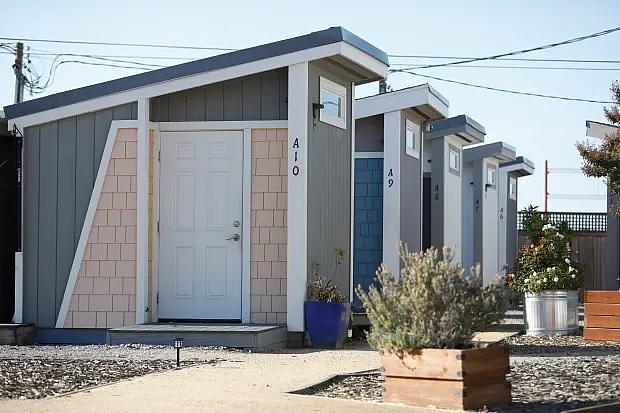Do tiny homes really work?

(Photo: Shae Hammond/Bay Area News Group)
I recently investigated whether “tiny homes” work as a solution to homelessness, for my fellowship project. These micro dwellings have swept the West Coast as a popular fix for our homelessness crisis in recent years. The idea is that people live in them for a few months before transitioning into permanent housing.
But my reporting found that that only happens about 25% of the time in Alameda County, and 50% of the time in Santa Clara County. The rest of the time, people are bouncing from tiny homes into other temporary shelters, or back to the street. That suggests that despite their popularity, tiny homes still have a long way to go.
To come to that conclusion, I had to gather and then analyze myriad data sources, as well as spend months following multiple people living in tiny homes. Getting the data posed the first challenge. While Alameda County was willing to hand over anonymized data tracking every person who had gone through a tiny home there in the last three years, Santa Clara County, citing privacy concerns, agreed only to give me aggregate numbers. After consulting with our attorney, I had to make the difficult decision to accept the data Santa Clara County was offering as “good enough” rather than spend time I didn’t have fighting with their officials on a matter where I might not win. I found communing with my senior fellow mentor to be particularly helpful as I was navigating this situation, as he provided a good objective second set of eyes.
Finding and following residents of the tiny homes proved to be the next challenge. I was able to meet a few people through introductions made by the nonprofits running the tiny homes. But that wasn’t possible in every case, and many of the tiny home communities wouldn’t let me inside to meet people. So I spent a lot of time standing outside the gates and trying to catch people coming and going. Eventually it paid off and I found several people interested in participating, but many were wary in the beginning. In order to gain their trust, I made it a point to visit them every week or every other week, just to check in, even if they didn’t have any big news to report. As I listened to their stories week after week, they opened up to me and taught me a lot about the tiny home system. I watched them go from excited and optimistic about their chances of finding permanent housing, to discouraged and downcast as the months went by and they got nothing but rejections from apartments. Watching their struggles first-hand helped me learn more about the process than 100 interviews with experts ever could have.
One man’s story really stuck with me. Robert Hernandez had moved into a tiny home in April after losing everything when a fire destroyed the RV he was sleeping in at a homeless encampment in San Jose. He had high hopes of using the tiny home program to transition into long-term housing. But when he sat alone in his new tiny home, without even a TV to distract himself, he couldn’t stop worrying about the loved ones – particularly two close friends with untreated schizophrenia – he’d left behind in the encampment. So he started going back to visit them, and eventually the tiny home said he’d been gone too long and gave his spot to someone else. His story was one you don’t hear very often, and it wasn’t necessarily the one I set out to find when I started my project. But in the end, I thought it summed up the tiny home experiment very well. It shows how there are so many difficult reasons why a tiny home might not work for someone.
Robert was a challenging source to stick with, as he kept bouncing around and he had no cell phone. After he left the tiny home, he went back to his encampment, where I would visit him once a week. One day I showed up and he was gone without a trace. After a few weeks of worrying I’d never see him again, I finally tracked him down in a nearby camp. Shortly after, he got another chance at a new tiny home.
I also paired up with one photographer throughout the entire reporting process, which I think really helped the visuals shine. She and I worked together to build relationships with our sources, and she came with me most days when I went to visit them. That way, she was able to capture really moving, personal shots that fit perfectly with my story.
In addition to the perseverance needed to gain my sources’ trust and keep track of them over a period of five months, organization was also key to my success. With such a large, daunting project before me, I found it helpful to make spreadsheets to keep track of everything from the different tiny home sites I was investigating, to the various sources I had talked to, to the status of my many public records requests.
Rather than closing the book on tiny homes, this reporting project has opened my eyes to many other questions. I plan to continue following the people I met during this process. Their journeys aren’t over. Even Christopher Henderson, who did succeed in going from a tiny home into permanent housing, still has a long way to go. His subsidy will eventually run out, at which point he’ll have to pay for his apartment all on his own – a transition that forces many people back into homelessness.
**

